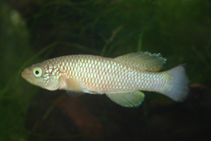| Diagnosis: |
Dorsal spines (total): 0-0; Dorsal soft rays (total): 14-16; Anal spines: 0-0; Anal soft rays: 16-18. Diagnosis: Nothobranchius lucius differs from all other species of the N. melanospilus group, except N. insularis, by having snout pointed in lateral view, jaws moderately long vs. snout blunt to weakly pointed, jaws short; caudal fin, in males, with broad dark grey to black band on the posterior margin vs. narrow; presence, in females, of dark dots over the whole flank vs. dark dots when present restricted to the posterior portion of the flank (Ref. 122074). It is distinguished from N. insularis by having inner premaxillary teeth larger than teeth of the outer premaxillary tooth row vs. smaller; caudal fin rounded in males vs. subtruncate; in females, flank dark dots are rounded and arranged in horizontal rows vs. dots vertically elongated, often arranged in oblique rows; unpaired fins, in females, with dark grey dots extending over most fin vs. dots restricted to the basal portion of unpaired fins; caudal, pectoral and pelvic fins longer, caudal fin length in males 31.3-34.9% of standard length and 30.3-32.9% of standard length in females of N. lucius, vs. 26.9-29.6% of standard length in males and 22.8-27.4% of standard length in females of N. insularis; pectoral-fin length 22.2-24.5% of standard length in males and 20.2-24.6% of standard length in females, vs. 17.1-21.8% of standard length and 14.2-19.3% of standard length, respectively; pelvic-fin length 11.6-13.1% of standard length in males and 11.5-13.0% of standard length in females, vs. 8.6-11.0% of standard length and 9.6-11.0% of standard length, respectively; and two neuromasts in the posterior section of the anterior supraorbital series vs. three (Ref. 122074).
Description: Dorsal profile slightly concave to nearly straight on head, convex from nape to posterior end of dorsal-fin base, about straight on caudal peduncle; ventral profile convex from lower jaw to anal-fin base, about straight on caudal peduncle (Ref. 83514, 122074). Body deep, compressed; greatest body depth at vertical between bases of pectoral and pelvic fins (Ref. 122074). Jaws short, snout blunt in lateral view; jaw teeth canine, numerous, irregularly arranged, outer teeth greater than internal teeth; mouth subterminal, directed slightly upward (Ref. 122074). Gill-rakers of first branchial arch 4 + 14-15; six branchiostegal rays (Ref. 122074). Drsal and anal fins moderate in males, extremity rounded, with short filamentous rays along distal margin, dorsal fin longer than anal fin; in females, dorsal fin rounded, anal fin sub-triangular and slightly longer than dorsal fin; caudal fin subtruncate; pectoral fin rounded, posterior extremity between pelvic-fin base and anus; pelvic fin small, tip reaching urogenital papilla; pelvic-fin bases medially in contact; dorsal-fin origin on vertical between base of first and second anal-fin rays; dorsal-fin rays 14-16; anal-fin rays 16-18; caudal-fin rays 29-31; pectoral-fin rays 19-20; pelvic-fin rays 6; minute contact organs on first and second pectoral-fin rays and distal portion of dorsal fin in males; rows of papillate contact organs along two distal thirds of most rays of anal fin in males (Ref. 122074). Scales small, cycloid; body and head entirely scaled, except ventral surface of head; minute filamentous contact organs along posterior margin of scales on middle portion of flank and latero-ventral portion of head in males; body squamation extending over anterior 30% of caudal-fin base; no scales on dorsal and anal-fin bases; frontal squamation irregularly arranged in two longitudinal rows; longitudinal series of scales 29-30; transverse series of scales 9-11; scale rows around caudal peduncle 16 (Ref. 122074). Anterior supraorbital series of neuromasts arranged in single section placed in shallow depression, with five neuromasts; in specimens above 45 mm standard length, anterior series partially divided in two sections, with two larger neuromasts in each section and smaller one between them; posterior supraorbital series with four neuromasts placed in shallow depression; infraorbital series with 16-17 neuromasts, pre-opercular series 12-13, mandibular 10-13; one neuromast per scale of lateral line (Ref. 122074).
Colouration: Colouration in alcohol of males: flank, dorsum and head light brown, darker on posterior portion of scales of dorsal portion of flank, dorsum and opercle; venter pinkish grey; pale grey spots on suborbital region; branchiostegal membrane dark grey; dorsal and anal fins hyalinewith transverse series of grey spots, almost inconspicuous in anal fin; caudal fin pale yellow with broad dark grey to black stripe along whole fin margin, broader on posterior margin; posterior sub-marginal area lighter; pectoral fin hyaline; pelvic fin greyish hyaline with black tip (Ref. 122074). Colouration in alcohol of females: flank and dorsum pale brown, side of head and venter pale yellow; rounded dark brown to black dots highly concentrated on whole trunk and head except venter, irregularly arranged in horizontal rows on flank; whole unpaired fins hyaline with dark grey dots; paired fins hyaline; few dark grey dots on basal portion of pectoral fin (Ref. 122074). |

